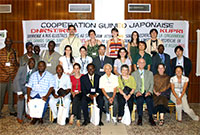HOME » Publications » Group Release of Sanctuary Chimpanzees (Pan troglodytes) in the Haut Niger National Park, Guinea, West Africa: Ranging Patterns and Lessons So Far
Group Release of Sanctuary Chimpanzees (Pan troglodytes) in the Haut Niger National Park, Guinea, West Africa: Ranging Patterns and Lessons So Far
International Journal of Primatology, Volume 32, Number 2, 456-473, doi: 10.1007/s10764-010-9482-7
Abstract
The release of wild or captive-bred mammals within their historical ranges typically aims to reestablish populations in areas where they have become extinct or extirpated, to reinforce natural populations, or to resolve human–wildlife conflicts. Such programs, which also typically in parallel help foster the protection of the release site, concern a wide range of endangered mammalian species, including our closest living relatives: chimpanzees. In June 2008, the Chimpanzee Conservation Center (CCC), which is located in the High Niger National Park (HNNP) in Guinea, released a group of 12 chimpanzees (Pan troglodytes verus) comprised of 6 females and 6 males (8–20 yr old). The selected release site lies 32 km from the sanctuary in the Mafou, a core area of HNNP where wild chimpanzees are also known to occur. The purpose of this release was therefore to reinforce the natural chimpanzee population within the Mafou core area and to promote the protection of the HNNP. Nearly 2 yr postrelease, 9 chimpanzees still remain free-living. Two thirds of the release chimpanzees were equipped with VHF-GPS store-on-board tracking collars. We used data from retrieved collars to explore the release chimpanzees’ habitat use, individual day range, and core area use (50% and 80%) during the first year of the release. Males traveled significantly further than females. Although minimum day range did not differ between the sexes or vary seasonally, some release males were active for longer during the day than the females. Males also ranged over larger areas and used a wider network of core areas than the females. Habitat use was similar to that recorded in wild chimpanzees in the HNNP. As of September 2010, 2 males and 3 females form a group at the release site. Two of these females gave birth to healthy offspring respectively 16 and 20 mo postrelease. Another female successfully immigrated into a wild chimpanzee community. We suggest that the success of this chimpanzee release can be attributed to the CCC’s lengthy rehabilitation process and the savanna-mosaic habitat of the HNNP. This release demonstrates that under special socioecological circumstances, the release of wild-born adult chimpanzees of both sexes is a viable strategy, which can also function as an effective conservation tool.
Keywords
Chimpanzee conservation center, Chimpanzee release, Core area, Day range, Habitat use
Full Text
PDF Download Please refer to the terms of use before downloading.





